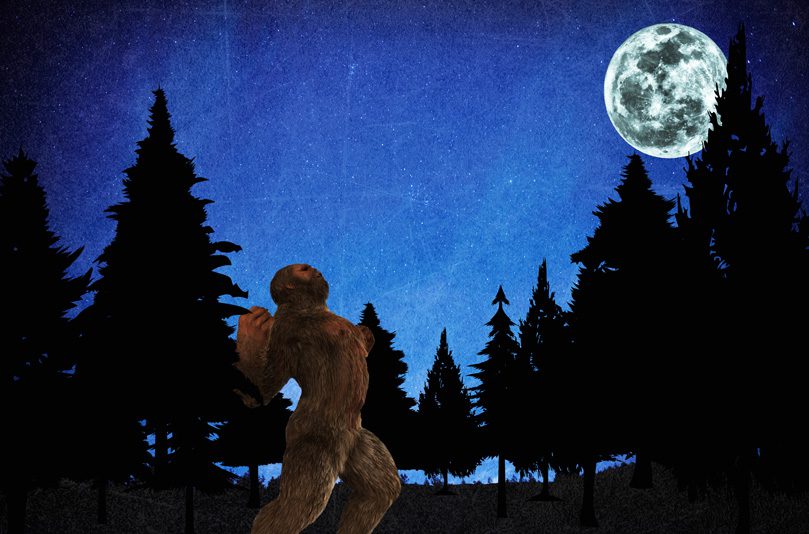
[dropcap]It’s[/dropcap] shortly before midnight on a foggy fall evening in 1988. My mother is driving us through the backcountry roads of Newalla. I am dozing in the back seat, when suddenly I lurch forward as my mother slams on her brakes, screaming wildly. Being a supportive daughter, I start in with my own bloodcurdling shrieks. Then, as abruptly as she began, my mother goes silent and calmly resumes driving. When I can open my mouth without my heart jumping out, I demand to know what’s going on.
“Oh nothing, baby,” my mom says, serenity personified. “It was just a bigfoot that ran across the road.”
Like many Oklahomans, I have grown up with tales of the creature. In southeastern Oklahoma, he is known as the Boggy Bottom Monster. Others call him bigfoot, sasquatch, hairy man, even the North American wood ape.
Recently, the North American Wood Ape Conservancy, a nonprofit organization of scientists, naturalists and investigators, published a comprehensive 230-page report on their findings from a long-term research study conducted regarding mysterious primate activity in Oklahoma’s Ouachita Mountains. While definitive results from photograph and lab analysis failed, the research group documented thousands of incidents, including rock hurling, knocking on wood and various unusual vocalizations, of which the group obtained several audio clips.[pullquote]With more and more people moving outward into those areas, more encounters with bigfoot is inevitable as humans encroach on [the creature’s] habitat.[/pullquote]
So how exactly does one “research” bigfoot? And why is Oklahoma such a hotbed of sasquatch activity and folklore?
We asked D.W. Lee, executive director of the Mid-America Bigfoot Research Center (MABRC). Although ostensibly a regional organization, it has attracted more than 500 members from three continents, seven nations and 42 states. Each year at the beginning of October, the center hosts the Oklahoma Bigfoot Symposium in Stilwell, where it presents the results of research and other expeditions in the quest to investigate the creature’s existence.
“I have been unfortunate enough to have 25 sightings of the bigfoot, out of being in the woods nearly 4,000 times during my time as a researcher,” Lee says. “I say ‘unfortunate’ because once you see these animals, you become obsessed with seeing them again.”
Lee attributes the high rate of bigfoot sightings in the state to a couple of different factors.
“Oklahoma has a larger concentration of lakes, watersheds and forests than many other states,” Lee says. “With more and more people moving outward into those areas, more encounters with bigfoot is inevitable as humans encroach on [the creature’s] habitat.”
A self-described armchair researcher and lifelong bookworm, MABRC researcher Glen McDonald first became intrigued when, as a teenager, he saw an unidentifiable creature stand up from a creek bed.
“I couldn’t see it clearly since I’d left my glasses at home,” McDonald says. “Whatever it was really scared the guys I was with.”
McDonald was hooked.
When asked why Oklahoma is indeed “Bigfootville,” McDonald agrees with Lee.
“I think this may be because Oklahoma has a lot of great habitat if bigfoot actually exists,” he says. “Oklahoma has a lot more water available year round in reservoirs and farm ponds than it did 100 [years] ago, for instance.”
He also believes that an upsurge in deer populations might make the Oklahoma forests and mountains attractive real estate for the creature.
Through their years of research with the MABRC, Lee and McDonald have made surprising discoveries about the cryptid during their numerous expeditions into some of the most remote areas of the state. And while McDonald admits that an expedition can be a great reason to go camping, both he and Lee emphasize that there is a lot more involved than just setting up tents and hunting for footprints.[pullquote]A creature similar to bigfoot was part of American Indian culture long before Columbus supposedly discovered our continent.[/pullquote]
“An expedition is not just an impromptu affair,” Lee says. “It’s planned out and detailed down to the last minute.”
Each potential research expedition, Lee explains, begins with scouting a location. When deciding on a potential area, teams search for such telltale signs as wooden structures and footprints and talk to locals about sightings.
“An expedition brings multiple researchers together, with their resources and with a common goal in mind,” Lee says. “It usually takes about two months prior to plan, coordinate and gather the resources together. Maps and aerial photos are studied, moon phases, sunset and sunrise [times] are collected. Sighting reports for the general area are reviewed. Several meetings are held by all the attendees online.”
Once an area is suspected as a likely spot for an expedition, the team conducts further research, setting up listening devices and recorders and thermal cameras. If the area shows great potential, a full expedition may be planned. Researchers arrive and set up trail and thermal cameras, audio recorders, parabolic devices and sometimes even military-grade motion sensors, Lee says.
Daytime activities include searching for tracks or other physical evidence. In the evening and nighttime hours, team members set up listening posts in the area and take four-wheelers into the woods. Even a short expedition of a few days can lead to hundreds of hours of video and audio that, along with any physical specimens collected, must be analyzed by members at the center.
“I’m still a skeptical agnostic on the existence of bigfoot,” McDonald says. “I’ve met a lot of folks who’ve had sightings. I don’t think everyone who has had a sighting can just be cynically dismissed as a nutcase. A creature similar to bigfoot was part of American Indian culture long before Columbus supposedly discovered our continent. I got involved in bigfoot research after I got acquainted with Ph.Ds, former police officers and a wide variety of other folks who are researching the bigfoot enigma. I know a lot of folks who absolutely believe that bigfoot exists.”
For those interested in conducting their own research expeditions, Lee has some words of wisdom.
“Bigfoot tends to stay close to water and food sources, and if you can locate good sources of this, you can find bigfoot activity,” he says. “Bigfoot is a flesh-and-blood animal, that is, a primate. No DNA study has since proven their existence, contrary to some folks who claim it has. They also do not cloak, disappear into portals into other dimensions or ride in UFOs.”
For those interested in learning more, the MABRC has a comprehensive database of bigfoot research and information at www.mid-americabigfoot.com.

























